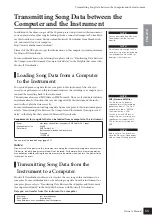
Playing Back Songs
Owner’s Manual
40
ENGLISH
Playing Back Songs
You can play back songs recorded using the Record function (pages 27 – 32) or commercially avail-
able songs. You can also play the keyboard along with the playback.
• The Demo Songs ....................................................................................... page 15
Playing the voice demo tune.
• 50 Piano Preset Songs .............................................................................. page 16
50 Piano Preset Songs in the instrument.
• User songs in the instrument .................................................................... page 41
User songs which you recorded to the instrument by using the record function (pages
27 – 32).
• External songs in the instrument .............................................................. page 41
Songs transferred from a computer (including commercially available songs and
songs which have been edited on a computer). Songs can be transferred (saved) to
the instrument by using the Musicsoft Downloader software (page 53). The songs are
saved to an area of the internal memory separate from the area for recorded User
songs. Up to 255 songs can be played back on this instrument (numbers 001 – 255).
• User Songs saved from the instrument in the USB storage device.......... page 42
SMF songs which have been saved from the instrument to a USB storage device (page
34).
• External songs in the USB storage device................................................. page 42
Commercially available songs or songs which have been edited on a computer, etc.
and stored to a USB storage device. Up to 999 songs can be played back on this
instrument (numbers 001 – 999).
Sequence formats that can be played
• SMF (Standard MIDI File) Formats 0 and 1
The SMF format is one of the most common and widely compatible sequence for-
mats used for storing sequence data. There are two variations: Format 0 and Format
1. A large number of MIDI devices are compatible with SMF Format 0, and most
commercially available MIDI sequence data is provided in SMF Format 0. The SMF
format for sequence files allows you to exchange song data between different
sequencers. User songs recorded in this instrument are saved as SMF Format 0.
• ESEQ
This sequence format is compatible with many of Yamaha’s MIDI devices. This is a
common format used with various Yamaha software.
Among ESEQ files, Disklavier Piano Soft songs can be played back on this instru-
ment.
NOTE
When playing back songs con-
taining various voices or parts
(such as XG or GM songs), the
voices may not sound correct or
as intended on the original. You
may be able to remedy this and
make the playback sound more
natural or appropriate by chang-
ing the Song Channel Selection
setting (page 47) to “1&2,” so that
only channels 1 and 2 will play
back.
NOTE
If the song cannot be selected or
loaded, you may need to change
the Character Code setting (page
50).
NOTE
Song data is not transmitted via
the MIDI connections. However,
channels 3 – 16 of Disklavier
Piano Soft songs and non-pro-
tected External songs will be
transmitted via the MIDI connec-
tions when the Song Channel
Selection is set to “1&2” (page
47).
NOTE
For the USB storage device,
folder directories on this instru-
ment can be recognized up to
two levels. However, the level is
not displayed and song numbers
001 – 999 are displayed which-
ever level the song contains.
NOTE
If the metronome is being used
during playback, the metronome
will automatically stop when play-
back is stopped.
NOTE
If the REVERB type is changed
via the panel controls during play-
back, both the playback and key-
board reverb effects will be
changed.
NOTE
If the EFFECT type is changed via
the panel controls during play-
back, the playback effect may be
switched off in some cases.






































